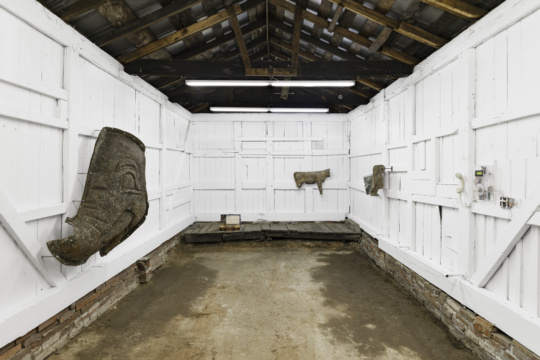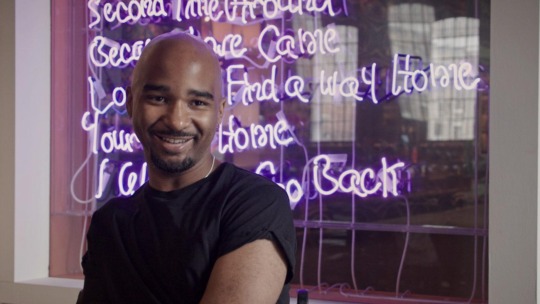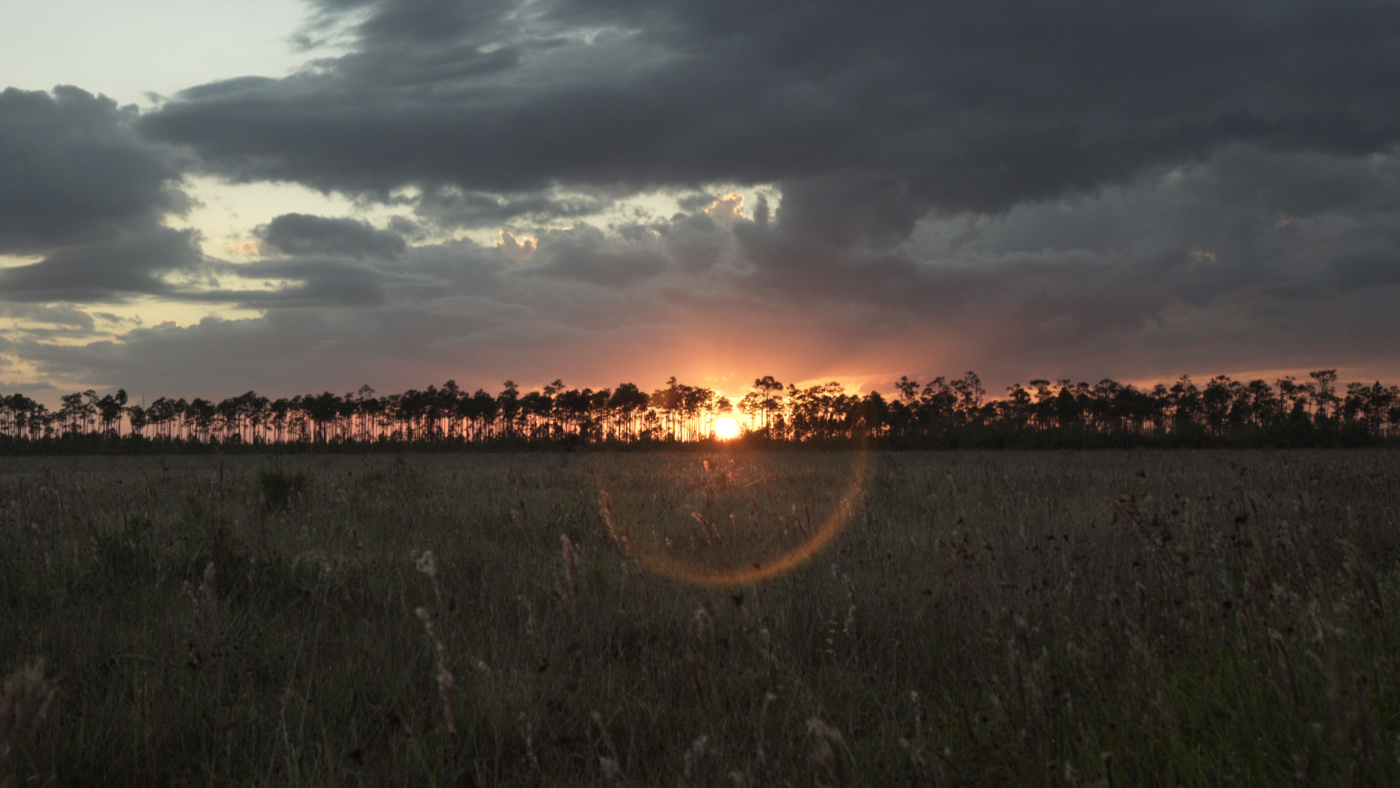
The magnificent beauty of Florida’s Everglades is genuinely unlike that of any other region. Comprised of nearly 400 species of fauna and over 1,300 species of flora, its biodiverse wetland ecosystem is found nowhere else on earth, home to alligators, bromeliads, birds, deer, star-shaped lilies. The watershed begins northerly, where the Kissimmee River rolls into central Florida’s Lake Okeechobee; the lake flows south over a limestone shelf into a colossal and languid river over 100 miles long, stretching across the state’s lower third into the Everglades’ beating heart and then spilling into the Gulf of Mexico. “The places where water comes together with other water / Those places stand out in my mind like holy places,” Raymond Carver once wrote. On a map, the Everglades looks like an open palm, reaching toward the sea.
I visited the Everglades in October with artist-filmmaker Sasha Wortzel and the Reverend Houston Cypress, a member of the Otter Clan of the Miccosukee Tribe of Indians of Florida. Cypress is an artist, activist, and head of Love the Everglades Movement, an Indigenous-led initiative to preserve the region. “We’re experimenting with ways to weave our different stories and communities back into the land—like the baskets the Miccosukee make with sweetgrass,” he says. The sawgrass melts into the water, blue-green. Cypress trees form close-knit glens—cypress domes—that filter the light, temporize and hold you. At night, the River of Grass becomes, as Cypress describes it, “a river of stars,” lustrous and still. He spent his childhood on the local Miccosukee reservation. “How can we listen to what the land is telling us?” he asks. “Cities are squeezing in on multiple sides. Their effluents exude into the landscape. How do we remember the stories? What are the songs that go along with that?”
In her 1947 book Everglades: River of Grass—a work revering the wetlands— the writer and conservationist Marjory Stoneman Douglas wrote, “The question was at once, where do you begin? Because when you think of it, history, the recorded time of the earth and of man, is in itself something like a river.” The perennially relevant query forms the overture of Somewhere Between, Wortzel’s short film on the history of the Everglades—how “histories of colonialism, and fundamentally altering the Everglades’ flow,” says Wortzel, shaped the state’s current realities. Somewhere Between prologues an upcoming feature-length film for which Cypress is consulting producer; Douglas is the film’s “spectral narrator,” explains Wortzel, a Florida native long enchanted by the Everglades. Throughout the film, the Everglades is a stately vista—the sun bowing toward it, palm trees like bastions.
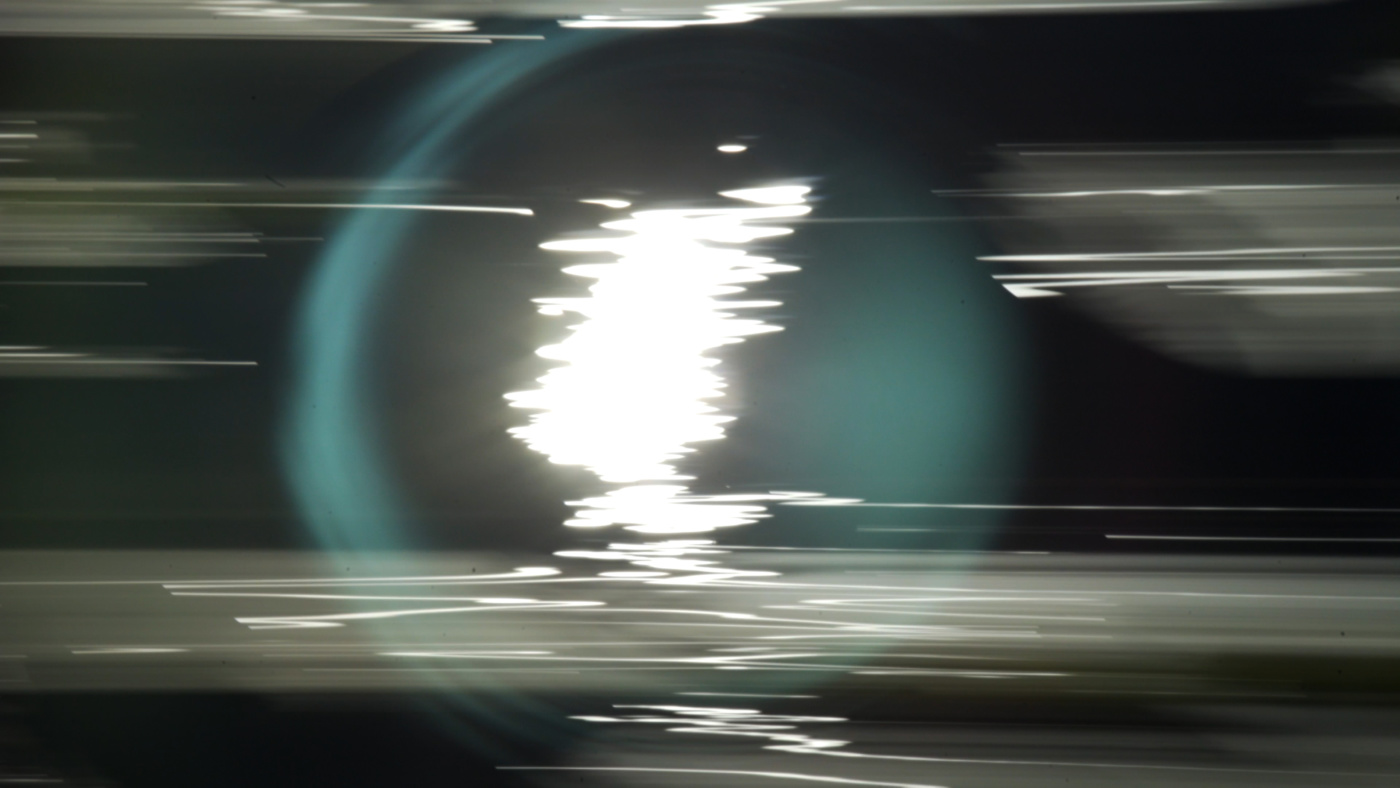
Where do you begin? To live in South Florida is to be part-palimpsest; nearly all of central and southern Florida was once Everglades. Draining, drilling, and canaling by developers made room for farmland crops—such as humidity-friendly sugarcane—in exchange for occasional saltwater intrusion, an ongoing problem, and the deference of the water’s natural flow into a series of pumps that determine where, when, and whom to flood. In 1928, a refusal by Fred Cotten Elliot—then Florida’s chief drainage engineer—to lower increasing water levels in Lake Okeechobee, lest he risk flooding affluent coastal communities, resulted in the third deadliest hurricane in U.S. history, disproportionately killing Black migrant farmers who’d relocated to Florida in search of stable work. The “problem” of water management became a federal one in 1947, when then-president Herbert Hoover tasked the Army Corps of Engineers with the Central and Southern Florida Project for Flood Control, a network of water regulation structures covering thousands of miles.
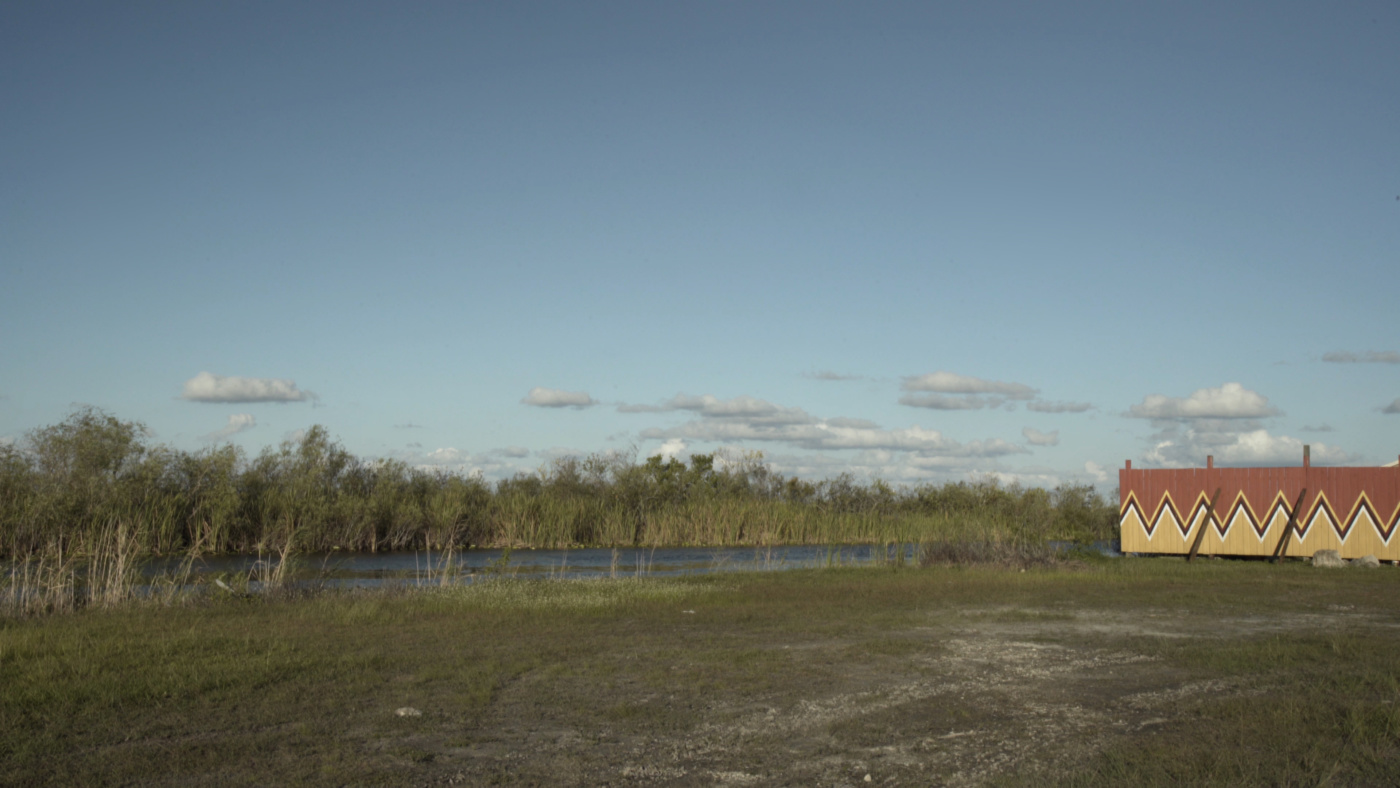
Today, the Miccosukee must lease their own ancestral land—much of which encompasses the Water Conservation Area, a C&SF Project subsection that acts as the system’s depository—from the state. (Another is the Everglades National Park, from which Indigenous communities—including Cypress’s grandparents—were forced out at gunpoint.) Under the Comprehensive Everglades Restoration Plan—an initiative undertaken by the State of Florida and the Army Corps of Engineers to restore the Everglades’ natural flow—even seemingly salubrious projects bring toxic runoff into Miccosukee land. Attempts to connect severed ecosystems, revive dying habitats, and protect endangered species are often conducted at the expense of their own health; in a cruel yet unsurprising irony, like many climate change “resilience” strategies, efforts to restore the Everglades operate under the same mechanisms—indeed, the Army Corps—that generated their assignment in the first place.
You’re an echo of the earth that you stand on, just by being in the body you’re in.
Somewhere Between traces these structures—levees, canals, pumps—as Wortzel’s camera pauses to introduce each: swaying sugarcane fields, the United States Sugar Corporation building in Clewiston, both stately and innocuous. The red-orange buoys guarding a pump gate chord with another glimpse of the florid color: the warm-red jacket cloaking conservationist Betty Osceola, of the Panther Clan of the Miccosukee Tribe. If Douglas is the film’s spectral narrator, Osceola might be its literal one: “The illnesses that you see in the water, in the air, in the ecosystem around you, are reflections of the illness that’s in you,” she says. “When decision-makers make those decisions of development…they’re also impacting the Indigenous people that survive in this environment.” Miccosukee sovereignty exists in synchronicity with the health of the Everglades. It always has. “I come from a universe where the word for ‘earth,’ yakne, rhymes with the word for ‘flesh,’ akne,” Cypress tells me. “You’re an echo of the earth that you stand on, just by being in the body you’re in.”
The Miccosukee currently operate their own scientist-led Environmental Protection Agency, with its own conservation practices and water quality standards. “We can point to a decolonial approach to science,” says Cypress. “By giving scientific, political, and communications tools to the Indigenous people, they’re giving you policies, science, practices, and protocol that point to increased biodiversity, strengthened sovereignties, and the beautiful art and spiritual practices that come from that. These areas of conflict, of stifled flow, are also sites of innovation.”
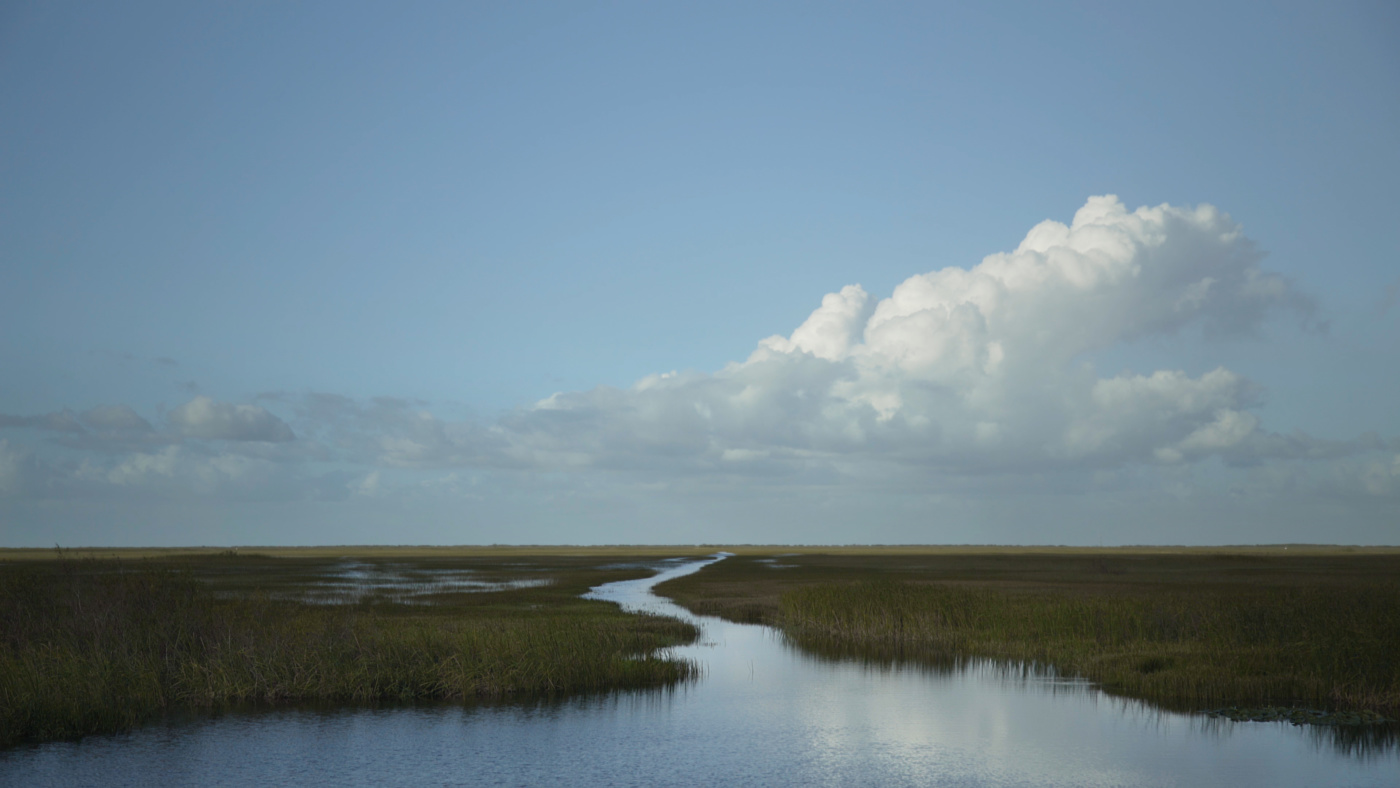
Cypress and Osceola bookend Somewhere Between, appearing toward its beginning and end: Cypress—in red, blue, and silver—gazing at a horizon we do not see; Osceola leading an airboat tour. The survival of the Everglades—and Floridians—hinges on the delicate balance of all this water. “The situation we’re dealing with is also the future of other communities,” says Cypress. “We’ve seen technologies of oppression experimented with on Indigenous communities before being exported to other communities.” He and Wortzel call for new knowledge systems that parallel and transcend both Indigenous taxonomies and the blinkered focus of modern science—a multilingualism, Cypress explains. “What are the experiences of the gender-diverse, the queer ecological knowledge we can build up together?” he asks, for example. “In Indigenous and Two-Spirit societies, we talk about gender diversity. It’s also about opening up spaces for our Creole- or Spanish-speaking friends, for the movement-and-choreography-minded, for people who are neurodiverse. Let’s find ways to speak each other’s languages, create new poetics in that.” There is also, both remind me, a surprising notion: “My elders counsel us regularly—take your time,” says Cypress. “If you rush, maybe you’ll forget you were supposed to invite a community or to sing that song that connects you to a sense of protocol with these plants or animals. Things are urgent—but it’s important to care for the process involved.” It could be challenging, too, says Cypress, to support Indigenous priorities. “It might threaten the order of your life,” Cypress says, “but that might be a good thing.” Toward the end of Somewhere Between, the sound of frogs, crickets, and Osceola’s burnt-red airboat sing a gentle chorus. The landscape opens again, the extended hand of the Everglades, like an invitation.

This essay is part of Burnaway’s yearlong series on Waterways / Water Wars.
Find out more about the three themes guiding the magazine’s publishing activities in 2020 here.

